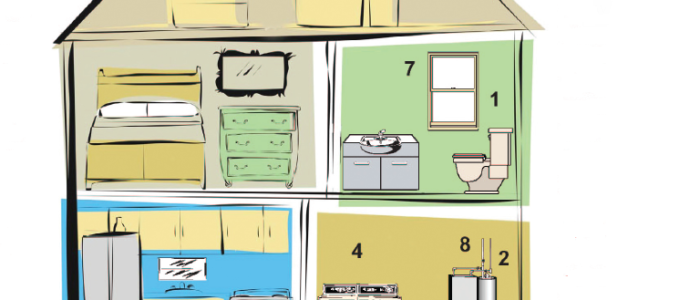10 Simple Steps for Healthy Indoor Air at Home
Are you concerned about indoor air hazards and the health of your family? Studies by the Environmental Protection Agency have shown air quality inside homes can be worse than outside. This concerns many families in an era when children spend up to 90% of their time indoors, and asthma and allergies are on the rise. Indoor levels of pollutants may be two to five times, sometimes more than 100 times, higher than outdoor levels. People in buildings frequently report discomfort and building-related health symptoms, and sometimes develop building-related illnesses.
Indoor air contaminants include excess moisture, cooking by products, mold, radon, carbon monoxide, formaldehyde, organic compounds from hobbies, furniture, carpet, and paint.
In the past, residential ventilation was not a major concern because it was felt people were getting enough outdoor air by opening their windows and by air leaking through the building’s walls.
Residents in southern climate zones are less likely to open windows because of high outdoor humidity, energy costs, security issues, drafts, noise and dirty air from outside.
Studies from the Environmental Protection Agency on ASHRAE standards cover new construction and upgrades to heating and cooling systems, but you can improve indoor air quality at your home today with recommendations that can be applied by homeowners.
1) Vent bathrooms, kitchens, water closets and laundry rooms directly outdoors with energy star rated bath fans.
2) Isolate ducts, heating and cooling, air handlers from garage and storage spaces containing contaminants.
3) Properly vent fireplaces, wood stoves and other hearth products; use tight doors and outdoor air intakes when possible.
4) Vent clothes dryers and central vacuum cleaners directly outdoors.
5) Store toxic or volatile compounds such as paints, solvents, cleaners and pesticides out of the occupiable space.
6) Minimize or avoid unvented combustion sources such as candles, cigarettes, indoor barbeques, decorative combustion appliances or vent-free heaters.
7) Provide operable windows to accommodate unusual sources or high-polluting events, such as the use of home cleaning products, hobby activities, etc.
8) Use sealed-combustion, power-vented or condensing water heaters and furnaces. When natural draft applications must be used. They should be tested for proper venting and should be located outside occupiable space when possible.
9) Put a good particle filter or air cleaner in your air handling system to keep dirt out of the air and off your ductwork, heating and cooling components.
10) Distribute a minimum level of outdoor air through the home using whole house mechanical ventilation.
Source: ASHRAE Standard 62.2, Ventilation and Acceptable Indoor Air Quality in Low Rise Residential Buildings and 2001 ASHRAE Handbook Fundamentals, Chapter 26, Ventilation and Infiltration. www.ASHRAE.org


Comments are closed.